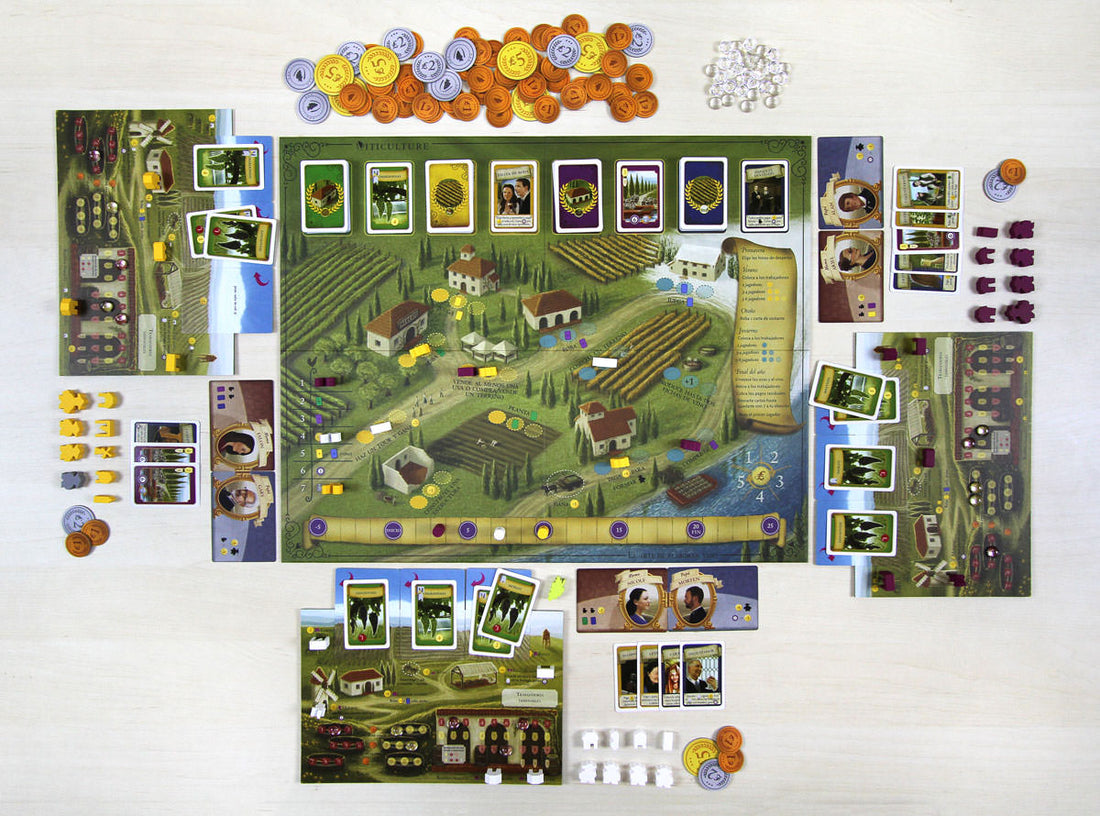Viticulture Essential Edition Review | Viticulture Essential Edition
Fulfill your winery dreams under the Tuscan sunshine in the ultimate worker placement game.
In this article, we will take a detailed look at the appeal of Viticulture Essential Edition, strategies, and things to be aware of, along with the voices of actual players.
Game Basics
This is a worker placement game set in the rustic setting of old Tuscany, where the player inherits a small vineyard and aims to turn it into Italy's best winery.
- Number of players: 1-6 (solo play supported)
- Playtime: 45-90 minutes
- Ages: 13 and up
- Designers: Jamie Stegmeyer, Alan Stone
The game progresses on an annual cycle.
It consists of four seasons: Spring (determining the order of waking up) → Summer (field work: construction, tree planting, tours, etc.) → Autumn (obtaining a visitor card) → Winter (harvesting, brewing, contract deliveries, training).
Each season has a different meaning in the vineyard, so workers can have different tasks in summer and winter.
The core mechanics are a combination of worker placement , hand management , and engine building .
By expanding fields, buildings, and workers, we will speed up the cycle of harvesting → brewing → delivery.
The allure of Viticulture: the ultimate thematic integration experience
It stands out in how perfectly the theme is integrated with the mechanics, and everything in the game makes sense in terms of running a winemaking business.
Intuitive and perfect theme integration
Viticulture stands out in how perfectly its theme is integrated with its mechanics.
Everything in the game makes sense from the perspective of running a winemaking business.
It feels like the designers really considered every aspect of running a winery before designing the game.
How wine moves through the game cycle, from planting the vines to fulfilling orders to customers, is still impressive nearly a decade later.
This thematic experience is outstanding.
Strategic dilemmas caused by wake-up systems
The spring "wake-up bonus" is an important strategic element.
Early risers get priority but the benefits are minimal, while late risers can speed up the second half with additional workers and cards.
The better the bonuses, the later your turn, which may limit your options for action spots on the board when summer begins.
The ingenuity of the Grande Worker System
Grande Workers can be placed on filled spaces, preventing them from being completely blocked.
Grande Workers don't get any bonuses (unless they arrive first), but they can act in spots that are already filled, opening up new possibilities for tactical play.
Visual beauty and quality
The clever graphic design using clear glass beads is impressive.
When the beads are placed on the white and red grape spaces, it looks as if there are tiny drops of grape juice on the board.
It moves to the left each round to represent maturation.
The artwork by Beth Sobel and the overall sleek lines of the worker placement spots and iconography are particularly striking.
Excellent scalability
The number of worker spaces is based on the number of players, so the game scales well with players.
Regardless of the number of players, there is ongoing competition for the spots you want.
The game lasts 45 minutes for two players, and 60 minutes or more with more players.
Concerns and solutions
There are a few points of concern, such as the luck element of card drawing and the monotony of the early stages, but there are effective countermeasures for each.
The luck element of card drawing
The worst aspect of Viticulture is definitely the card draw.
Sometimes you're lucky enough to have a Summer Visitor Card that suits your needs perfectly, but other times you'll need to hold onto a Winter Visitor Card, which is pointless until more vineyards and wines are ready and you have to hold onto it for a long time.
Solution: Some people dislike the randomness that visitor cards provide, but you don't really need to use them.
There is also an action spot where you take at least one visitor card each fall and play them, but you don't have to use them.
At the end of each year, you must reduce your hand to seven cards, making it easy to discard cards if you don't like the element of luck.
Monotony in the beginning
Charles Hasegawa points out that early in the game, each player is doing "very similar things" with slight variations.
Solution: Asymmetrical starts (Mamas & Papas) provide strategic variety, allowing for different approaches from the start of the game.
Additionally, because there are multiple valid strategies and all strategies are well-balanced, it is rare for one player to have such a large lead that others are unable to catch up.
Two-player restrictions
In two-player mode, there is only one action spot per activity per year, which is very tight.
If your opponent does something, you won't be able to take that action at all that year.
Solution: You have limited options, so you need to play smart.
In two-player games, Visitor cards play a more important role in strategy, requiring additional actions and possible bonuses.
Recommended for these people and occasions
It's a game that can be enjoyed by beginners and advanced players alike, and is also ideal for those who value the theme and solo players.
For beginners to advanced
Viticulture is not too difficult to explain.
Once the rules are well explained, the action makes a lot of sense, making it accessible to new players yet challenging enough for experienced players.
This is the perfect game if you enjoy Wingspen and want to take it to the next level .
It's easy to learn, but with the addition of summer and winter cards there are layers of play and tactics.
People who care about the theme
This is perfect for those who want to experience the atmosphere of winemaking and feel like they are actually making wine.
It's fun to play while sipping wine, and the game's integration of theme and mechanics is excellent.
Families and casual gamers
It's fun for a variety of player counts and experience levels, and no one has ever walked away saying, "I never want to play again."
It doesn't outstay its welcome in terms of time, and you can get a fulfilling experience in around 90 minutes.
Solo Player
It has an excellent solo Automa system and can be used by one or many people.
Viticulture and Scotland Yard have top-rated solo modes.
Strategy game enthusiasts
Decisions are always important and the scores between players are almost always close.
Planning well is key, as well-thought-out decisions can give your score a big boost.
Paying attention to other players, thinking ahead, and having a backup plan if your actions are blocked are key to running a successful winery.
Check the product on the online store page
Free shipping throughout Japan. Orders placed before 3pm will be shipped the same day.
Reference source/quote source

